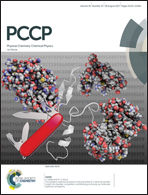Interpretation of the à ← ![[X with combining tilde]](https://www.rsc.org/images/entities/char_0058_0303.gif) transition of hydrated protons in aqueous solutions observed in the far-UV region with quantum chemical calculations†
transition of hydrated protons in aqueous solutions observed in the far-UV region with quantum chemical calculations†
Abstract
Far-ultraviolet spectra (wavelength: 140–200 nm) of group I, II, and XIII cation nitrate electrolyte aqueous solutions show that the first electronic transition (à ← ![[X with combining tilde]](https://www.rsc.org/images/entities/char_0058_0303.gif) ) energies of water hydrating the cations are linearly dependent on the hydration energies of the cations. However, deviations from these linear relations have been observed only for electrolyte solutions of small cations, i.e., H+, Li+, and Be2+ (T. Goto, A. Ikehata, Y. Morisawa, N. Higashi and Y. Ozaki, Phys. Chem. Chem. Phys., 2012, 14, 8097–8104). In this study, the à ←
) energies of water hydrating the cations are linearly dependent on the hydration energies of the cations. However, deviations from these linear relations have been observed only for electrolyte solutions of small cations, i.e., H+, Li+, and Be2+ (T. Goto, A. Ikehata, Y. Morisawa, N. Higashi and Y. Ozaki, Phys. Chem. Chem. Phys., 2012, 14, 8097–8104). In this study, the à ← ![[X with combining tilde]](https://www.rsc.org/images/entities/char_0058_0303.gif) transitions of group I cation–water clusters holding the first and second shell water molecules around the cations (M+(H2O)6, M+: H+, Li+, Na+, and K+) were studied with quantum chemical calculations to elucidate the cation size effects on the electronic states of each shell water molecule. The calculation results show that the à ←
transitions of group I cation–water clusters holding the first and second shell water molecules around the cations (M+(H2O)6, M+: H+, Li+, Na+, and K+) were studied with quantum chemical calculations to elucidate the cation size effects on the electronic states of each shell water molecule. The calculation results show that the à ← ![[X with combining tilde]](https://www.rsc.org/images/entities/char_0058_0303.gif) transitions of the small cation clusters, especially H+, are more intensely split than those of the larger cation clusters, because of the difference in the à ←
transitions of the small cation clusters, especially H+, are more intensely split than those of the larger cation clusters, because of the difference in the à ← ![[X with combining tilde]](https://www.rsc.org/images/entities/char_0058_0303.gif) transition of each shell and the asymmetric structure of H+(H2O)6. Specifically, the à ←
transition of each shell and the asymmetric structure of H+(H2O)6. Specifically, the à ← ![[X with combining tilde]](https://www.rsc.org/images/entities/char_0058_0303.gif) transitions of the first shell water molecules are mostly ascribed to the charge transfer transition of the nonbonding electrons to the central cations, while those of the second shell water molecules are ascribed to the transition to the σ* orbitals of the second shell water molecules. Moreover, the condensed and distorted structure of H+(H2O)6 causes an asymmetrically delocalized electronic distribution in the excited state, as well as the ground state, because the electronic interference from the second shell water molecules weakens the exciton–hole interaction of the first shell. These interpretations based on calculations provide a detailed explanation concerning the substantial blue-shift of the à ←
transitions of the first shell water molecules are mostly ascribed to the charge transfer transition of the nonbonding electrons to the central cations, while those of the second shell water molecules are ascribed to the transition to the σ* orbitals of the second shell water molecules. Moreover, the condensed and distorted structure of H+(H2O)6 causes an asymmetrically delocalized electronic distribution in the excited state, as well as the ground state, because the electronic interference from the second shell water molecules weakens the exciton–hole interaction of the first shell. These interpretations based on calculations provide a detailed explanation concerning the substantial blue-shift of the à ← ![[X with combining tilde]](https://www.rsc.org/images/entities/char_0058_0303.gif) band of aqueous sulfuric acid solutions.
band of aqueous sulfuric acid solutions.
![Graphical abstract: Interpretation of the à ← [[X with combining tilde]] transition of hydrated protons in aqueous solutions observed in the far-UV region with quantum chemical calculations](/en/Image/Get?imageInfo.ImageType=GA&imageInfo.ImageIdentifier.ManuscriptID=C7CP01766A&imageInfo.ImageIdentifier.Year=2017)


 Please wait while we load your content...
Please wait while we load your content...
![[X with combining tilde]](https://www.rsc.org/images/entities/h2_char_0058_0303.gif) transition of hydrated protons in aqueous solutions observed in the far-UV region with quantum chemical calculations
transition of hydrated protons in aqueous solutions observed in the far-UV region with quantum chemical calculations